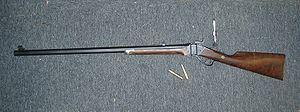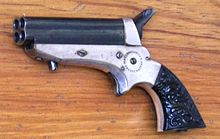Sharps Rifle
| Sharps Rifle | |
|---|---|
| general information | |
| Civil name: | Sharps rifle |
| Developer / Manufacturer: | Christian Sharps / Sharps Rifle Manufacturing Company |
| Development year: | 1848 |
| Manufacturer country: | United States |
| Production time: | 1848 to 1882 |
| Weapon Category: | gun |
| Furnishing | |
| Overall length: | 1200 mm |
| Technical specifications | |
| Caliber : | .52 |
| Cadence : | 8-10 rounds / min |
| Fire types: | Single fire |
| Visor : | (Folding) ladder sight |
| Closure : | Block closure |
| Charging principle: | Single loader |
| Lists on the subject | |
The Sharps rifle is a einschüssiges Hinterlader - rifle with a case, block closure , which is actuated by the trigger guard. It was designed by Christian Sharps (born November 1, 1810, Washington, New Jersey ; † March 12, 1874, Vernon) and manufactured by the Sharps Rifle Manufacturing Company. The rifle was patented in 1848 and production began in 1850.
history
The first hundred of the Sharps Model 1849 single-shot fall-block buckle, patented September 17, 1848 , were manufactured by AS Nippes of Mill Creek, Philadelphia , Pennsylvania . In 1850 an improved series of around 150 weapons from the same manufacturer followed.
The weapon was further developed by Richard S. Lawrence for industrial production; however, the Model 1851 did not yet correspond to the Model 1852 or Boxlock Model , which established the success of the Sharps rifle. The guns were manufactured by the Robbins & Lawrence Company , of Windsor, Vermont ; Sharps Rifle Manufacturing Company Holding with a capital of 1,000 US dollars was responsible for the management of the business .
After the weapon had proven itself in use with the US Dragoons used in Texas and New Mexico, a large number of the Model 1852 and its successors were sold to the US Army , and 6,000 carbines were delivered to the British armed forces. After the Robbins & Lawrence Company went bankrupt , production was taken over by Sharps Rifle Manufacturing Company in Hartford , Connecticut .
The Sharps Rifle Manufacturing Company became an important arms supplier to the Union troops in the American Civil War and later manufactured powerful hunting rifles. Hugo Borchardt designed the last rifle made by this company, the Sharps-Borchardt Model 1878. The company finally closed its doors in 1881.
Christian Sharps left the company in 1853 and moved to Philadelphia, where he founded C. Sharps & Company in 1854 . There he manufactured single-shot pistols with a drop block, later pistols with four barrels in a package as well as carbines and rifles followed. With these weapons, the barrel package or barrel was pushed forward for reloading. From 1862 to 1866, Sharps partnered with William Hankins, at which time the company was called Sharps & Hankins . Sharps remained in the arms business until his death in 1874.
technology
The Sharps rifle has a block lock (Sharps' patent from 1848). From 1859, earlier weapons were switched to the use of metal cartridges. Around the same time, the first guns for cartridge ammunition were made. By using the metal sleeves, the sealing problems disappeared. The Sharps block closure is still considered very robust today.
The downward movement of the extended trigger opens the breech, and the upward movement closes it again. When the closure is opened, the powder chamber is opened. A paper cartridge is inserted into this. The paper cartridge was made a few millimeters longer than the chamber. The reason for this was that when the chamber is closed, the breech (also called a paper cutter) cuts off the rear part of the paper cartridge, thus exposing the gunpowder. In order to achieve a gas-tight seal, a movable sleeve (gas sealing sleeve) was built into the cartridge chamber, which moves backwards when the shot is fired and is supported on the breech block, thus ensuring a relatively gas-tight seal. This cuff is based on a patent from Hezekiah Conant from 1856 and was replaced by a movable gas sealing plate on the shock base, which is much less sensitive to black powder deposits, due to malfunctions in the further development. In today's common replicas, both, i.e. the gas sealing plate together with the gas sealing sleeve, are often installed. The locking block has a cone in the middle with a small hole through which the ignition takes place. The gas sealing plate also has the task of keeping the powder chamber tight.
With the later Sharps models for metal cartridges (e.g. .45-70 etc.) the gas sealing sleeve could be dispensed with because the brass sleeve , which expands slightly when fired, provides the gas sealing . The first constructions (1848 to 1852) were ignited with detonators. Later, the automatic ignition device designed by Edward Maynard was also used, in which a paper strip with detonators was pushed onto the piston when the cock was cocked . In 1852/1853 and 1859 and later, the Sharps Pellet Primer , an automatic ignition device that operated with individual detonators, was used. From 1861, loose primers were added to the ammunition.
Sharps carbines and military rifles
Sharps carbines and rifles were tested by the US Army from 1851 and a limited number were purchased. After the outbreak of the Civil War, the weapon was used in large numbers, although the main armament of the troops was still muzzle-loaders. The Sharps rifle fired paper cartridges , but not percussion primers were used for ignition , but primers that were automatically placed between the piston and the cock when the cock was operated. This made reloading easier, especially when used on horseback.
Sharps military carbine
The carbine was very popular in the American Civil War, with both Union and Confederate cavalry units . It is estimated that the Union Forces had over 80,000 Sharps carbines in use, while the Confederate Cavalry had over 5,000 Southern-made Richmond Sharps carbines. A rare variant of the Sharps carbine was the Coffee-Mill Sharps with a coffee grinder built into the piston. After the Civil War, a large number of the carbines were converted for use with the metal cartridges that appeared in the late 1860s. These conversions in caliber .50-70 (rim fire) and .50-70 Government (central fire) were used for years in the Indian Wars.
Sharps military rifle
Under the name Berdan Sharps Rifle known Model 1859 rifle was the "Berdan's Sharpshooters" ( snipers used successfully). The name goes back to their leader Hiram Berdan. From this high quality sniper rifle with binoculars -deduction 2,000 copies were given to the two sniper regiments. By the end of the war, infantry and naval troops were equipped with a total of around 12,000 Model 1859 and 1863 Sharps infantry rifles without trigger trigger. Various weapons remained in use until they were replaced by the Springfield Model 1873 rifles .
Sharps sport rifle and buffalo rifles
Sports versions of the Sharps rifle were also made between the late 1840s and 1880s. Rifles, which were in abundance after the Civil War, were also converted into rifles for private use.
The models 1869 and 1874 were developed and produced in large numbers for commercial buffalo hunting . These weapons for long-range shooting were designed for the most powerful gunpowder ammunition at the time .
The 1878 model developed by Hugo Borchardt for Sharps & Co. no longer had an external tap, the ignition mechanism was located in the drop block lock and was automatically cocked during loading. Of this modern weapon for its time, 384 were made as carbines and a little over 6900 as infantry rifles in .45-70 Government caliber . In addition, there were a little less than 1500 hunting rifles in .45 and .40 calibers. Production ceased in 1881 and Hugo Borchardt set about developing the Borchardt Mod 1893 pistol , the forerunner of the Luger pistol .
Sharps loaders
When single loader sales declined in the late 1870s, attempts were made to enter new markets.
As early as 1875, contacts were made with weapon designers such as Andrew Burgess , known for his Burgess lever action rifle , Friedrich Vetterli and James Paris Lee in order to produce a repeating rifle they had developed , after which a collaboration with Lee was established in 1878. The Lee Arms Co. Bridgeport , based at the Sharps Company, began manufacturing 300 of the bolt-action bolt-action rifles developed by Lee with a .45-70 caliber magazine for army testing. The weapons were not completed because Hugo Borchardt, the only one with hands-on experience in the industrial production of weapons, left the company in September 1878. After all, there are some high-quality Lee bolt action rifles that clearly bear Borchardt's signature.
The production of the Lee military repeater was successfully taken over by Remington Arms , who made over 100,000 of these weapons. Further evidence of the quality of Lee's design is that its further development, the Lee-Enfield , was successfully used as an orderly rifle by the British armed forces during World War I and World War II .
The end
In addition to trying to get into the production of bolt action rifles, Sharps planned to offer side-by-side shotguns manufactured by Webley & Sons in England under the brand name Old Reliable Sharps Rifle Co. This project was also unsuccessful on the market, no more than 150 of these weapons were sold in total, and the company got more and more financial difficulties.
In order to raise money, rifles were also assembled from parts in stock. Weapons that were taken back and some of them no longer new were revised and new parts were added. These weapons no longer corresponded to a specific model, they were stamped with an A (For Assembled) in an octagon. Despite all efforts, the company could no longer be saved and production ceased in 1882.
The Sharps company continued to exist as a real estate owner for a few years and finally disappeared from the Connecticut state directory in 1904.
Use today
Sharps rifles are still used by gunpowder shooters in shooting sports and for hunting. Mostly replicas are used , but also originals. Replicas are made for example Sharps 1853 rifles (loaded with paper cartridges), Sharps 1861 rifles (with metal cartridges and percussion), Sharps 1874 rifles (with metal cartridges and central fire) or the Sharps-Borchardt Model 1878.
In the 1970s, Colt (Hartford) offered a limited series of 500 Sharps-Borchardt hunting rifles in calibers .22-250 Remington, .243 Winchester , .25-06 Remington, 7 mm Remington Magnum, .30 -06 Springfield and .375 Holland & Holland Magnum . The weapons had no sights or front sight; they were equipped with a telescopic sight as standard.
Web links
- Christian SHARPS self-capping system - US Patent no.5,763 (1818) Edward MAYNARD tape-primer system on Sharps 1855 model US Patent no.4,208 - 1845
literature
- Norm Flayderman: Flayderman's Guide to Antique American Firearms . Krause Publications, Iola, WI 1971, ISBN 0-87349-313-3 .
- Marfe F. Delano, Barbara C. Mallen: Echoes of Glory, Arms and Equipment of the Union . Time Inc. Book Company, New York, NY 1991, ISBN 0-8094-8855-8 .
- Marfe F. Delano, Barbara C. Mallen: Echeos of Glory, Arms and Equipment of the Confederacy . Time Inc Book Company, New York, NY 1991, ISBN 0-8094-8851-5 .
- Frank Sellers: Sharp's Firearms . Beinfeld Publishing Inc., North Hollywood, CA 1978, ISBN 0-917714-12-1 .
- Wolfgang Stephan: Shooting with percussion breech loaders - Sharps carbine & Sharps rifle. Self-published, Coburg, 2003, ISBN 3-00-011447-5 .
Individual evidence
- ^ Sharps Rifle Manufacturing Company in the English language Wikipedia
- ↑ Mr. Fuller's Most Peculiar Firearm. (PDF, 38 kB) Archived from the original on February 18, 2013 ; accessed on January 4, 2016 .
- ↑ Hiram Berdan in the English language Wikipedia











